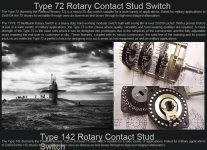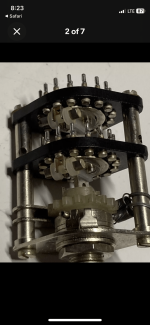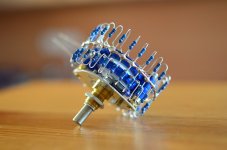I don't know whether you have seen this thread in the parts section?
Potentiometer Overview - Alps, Penny+Giles, TKD and Vishay and more, what's your fav?
I've had an alps blue in the commercial amp, yet over time it's got a little noisy on adjustment.
I think initially I will simply go for a simple, low cost one and then later add something as the amp gets more added.
Potentiometer Overview - Alps, Penny+Giles, TKD and Vishay and more, what's your fav?
I've had an alps blue in the commercial amp, yet over time it's got a little noisy on adjustment.
I think initially I will simply go for a simple, low cost one and then later add something as the amp gets more added.
Exactly, models other than Alps Blue. I don't think that would be the best choice.
Thanks for the link.
Thanks for the link.
DIY pot
I have a few Noble pots and they are pretty darned reliable. Not certain if they are still readily available though. If you're prepared to do some calculations, resistor matching and plenty of soldering, see if you can get hold of a Plessey Type 72 quad bank rotary switch. They're not too expensive as I recall, and are extremely rugged. Ideal for making up a 2-resistors-in-the-path volume control. There is a spreadsheet available somewhere (just can't recall where I found it) to help with the calculation of the resistor values.
I have a few Noble pots and they are pretty darned reliable. Not certain if they are still readily available though. If you're prepared to do some calculations, resistor matching and plenty of soldering, see if you can get hold of a Plessey Type 72 quad bank rotary switch. They're not too expensive as I recall, and are extremely rugged. Ideal for making up a 2-resistors-in-the-path volume control. There is a spreadsheet available somewhere (just can't recall where I found it) to help with the calculation of the resistor values.
Attachments
knauf1919 take a look at this web page:
Resistor-Switch Attenuator Networks for Audio Volume Control
Resistor-Switch Attenuator Networks for Audio Volume Control
You could work out the best switch-resistor by using a neural network (a back propagation would work). Simply make the values between the nodes only be of the set of resistor values available, then score for (a) correctness of of resulting resistance, (b) shortness of run (ie least number of resistors), (c) shortness of run through number of switches. You could even add the number of solder joints into it.
Let it rip and then it would iterate and narrow down the best score the value neural network which just so happens to have connections required to have the best switched attenuator.
Computer science helps the age old problem of volume 😉
Let it rip and then it would iterate and narrow down the best score the value neural network which just so happens to have connections required to have the best switched attenuator.
Computer science helps the age old problem of volume 😉
Not cheap but no noise, NO STEREO ! 🙂
Yes, I forgot. I only does designs for guitar (so MONO) 😉
Yes, I forgot. I only does designs for guitar (so MONO) 😉
So surely it's possible to create an active opamp circuit that simply uses the mono as a reference for both channels? C'est complique
I imagine with an ADC that has I²C or SPI output for 2 digital pots, it should be possible.
The ADC "reads" the value of analog pot, then send to the 2 digital pots the information to have same value on the 2 digital pots than on the analog pot.
However, I don't sure you will find an ADC and a digital pot which will have same protocole to communicate.
Using a µC is a solution. More complicated than a stereo pot except if you have already a µC in you design (for remote control or screen for example).
The PIC16F15213 could be a good choice because it exists in DIP8 & SO8 package. A dev kit is available: Welcome to MicrochipDirect
P.S : I prefer the stereo solution because digital pots carries more THD+N than analog pot. However, I think you can have a good sound with digital pots. Depend on your need.
The ADC "reads" the value of analog pot, then send to the 2 digital pots the information to have same value on the 2 digital pots than on the analog pot.
However, I don't sure you will find an ADC and a digital pot which will have same protocole to communicate.
Using a µC is a solution. More complicated than a stereo pot except if you have already a µC in you design (for remote control or screen for example).
The PIC16F15213 could be a good choice because it exists in DIP8 & SO8 package. A dev kit is available: Welcome to MicrochipDirect
P.S : I prefer the stereo solution because digital pots carries more THD+N than analog pot. However, I think you can have a good sound with digital pots. Depend on your need.
Last edited:
You can get digital potentiometers - ie chips that simply perform the resistor switching on chip. If there's a 2 channel version of it, that would work!
Unfortunately the links doesn’t work anymore.knauf1919 take a look at this web page:
Resistor-Switch Attenuator Networks for Audio Volume Control
I just got hold of a 15-step plessey rotary switch, trying to make a 10% log taper log step potentiometer with it.
Want to figure the resistors required for each step. So at 1/2 setting it should be 5K Ohm, at quarter setting is 500 Ohm? 3 Quarter is 4.5K Ohm?
Could some experts show me the correct way of calculating the desired resistors for each step?
Attachments
Where's the thread(s) that uses homemade LED-LDR things (once a commercial product known as Vactrol, now a genericized word vactrol) for volume? There's a long-time thread where someone was selling a stereo volume control using a matched set of those. It's gotta be here somewhere. All you need is LDRs (which are unfortunately banned in many areas due to ROHS regulations).
https://www.google.com/search?q=ldr+site:diyaudio.com
https://www.google.com/search?q=ldr+site:diyaudio.com
That was called the "Lightspeed" attenuator - might help you find some more information 🙂
Not sure how transparent LDRs are, but they can't be too bad as some higher end studio compressors use them.
Fet based shunt volume controls can sound very good and track precisely being controlled by the same voltage source ie. like a VCA. Some fets sound better than others for this application.
Fet based shunt volume controls can sound very good and track precisely being controlled by the same voltage source ie. like a VCA. Some fets sound better than others for this application.
The “light speeds” had to be matched and then they would drift, they were short lived. The muses attenuator looks pretty promising, not sure why the diy audio store has not added a kit to their lineup.
Bill
Bill
- Home
- Amplifiers
- Headphone Systems
- Volume Control potentiometer


